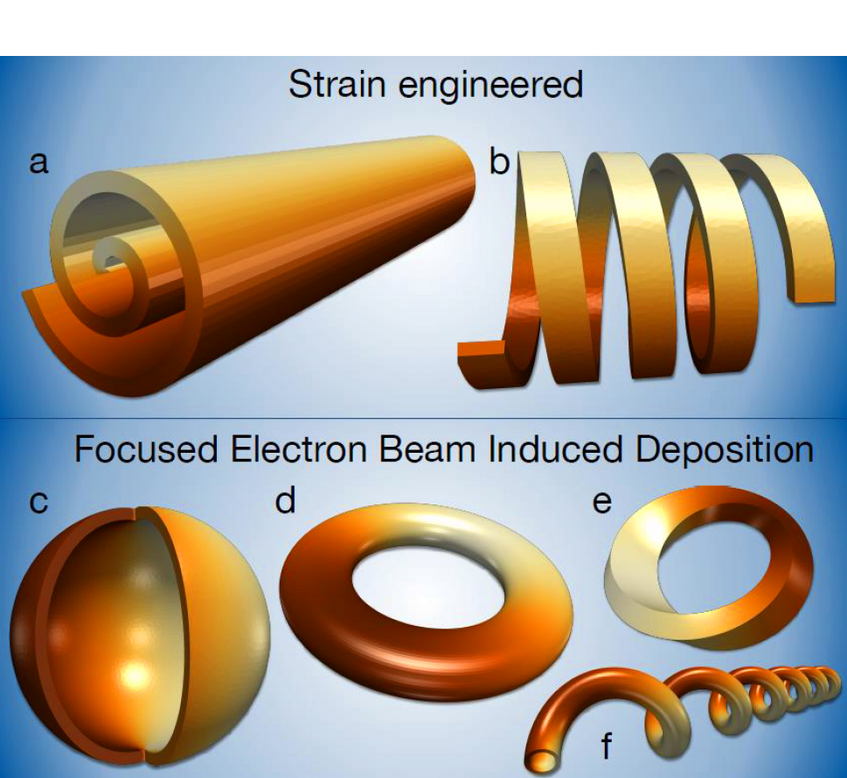CurviMag: Cuvature effects in magnetic nanostructures
FWF project I 4889-N “Curvature-induced effects in magnetic nanostructures”.
01.09.2020 – 31.12.2023
Principal Investigator: PD Dr. habil. Oleksandr Dobrovolskiy
Scientific Staff: Sebastian Lamb-Camarena
Partners:
Prof. Dr. Michael Huth, Thin Films and Nanostructures Group
Physics Institute, Goethe University Frankfurt am Main, Germany
PD Dr. Attila Kákay, Curvilinear Micromagnetism Group
Helmholtz-Zentrum Dresden-Rossendorf, Dresden, Germany
Dr. Denys Makarov, Intelligent Materials and Devices Department
Helmholtz-Zentrum Dresden-Rossendorf, Dresden, Germany

Our project “Curvature-induced effects in magnetic nanostructures” is concerned with experimental and theoretical investigations of complex magnetic states and their dynamics in curved magnetic shell structures.
Materials harboring complex magnetic states are at the forefront of current condensed matter research. Curvature effects in magnetic thin films have emerged as a viable alternative to conventional approaches towards the realization of chiral magnetic textures, which are based on tuning of intrinsic properties of materials. Although there are numerous appealing theoretical predictions of curvature-induced effects in 3D shell nanostructures, the novel physics of exchange- and magnetostatics-driven phenomena is not explored experimentally. This is mainly due to the lack of fabrication methods and characterization tools which can provide access to complex geometries at the low micrometer and sub-micrometer scale, e.g. tori, Möbius strips, and spherical shells.
The main objective of this project is to develop and exploit novel routes in fabrication of 3D curved magnetic nanostructures on the basis of thin-film and direct-write methods, and to investigate complex magnetic states and their dynamics therein both, experimentally and theoretically. In the focus will be mainly objects which were not realized before, including but not limited to torus, Möbius strip, and spherical shell. These new magnetic architectures will be characterized using a broad range of experimental techniques with respect to their static and dynamic properties. For the latter, new methods will be established and applied to study magnetization dynamics, e.g. in fundamentally appealing radially magnetized Swiss rolls. To understand complex magnetic structures in these architectures, advanced micromagnetic simulations will be carried out using finite element based micromagnetic solvers. The project will not only deepen our understanding of the curvature-induced effects in condensed matter but also will help to examine novel theoretical concepts experimentally. This will provide insight into how curvature effects can be used for future realization of novel 3D devices.
The four Partner Teams of researchers gathered around this German-Austrian collaborative project constitute a rich panel of complementary expertises with proven track records of excellent scientific research. The German Teams are led by Denys Makarov and Attila Kákay from the Helmholtz-Zentrum Dresden-Rossendorf and Michael Huth from the Physics Institute, Goethe University Frankfurt am Main. The Austrian Team is led by Oleksandr Dobrovolskiy from the Faculty of Physics, University of Vienna.
Project publications
- Merging of spin-wave modes in obliquely magnetized circular nanodots
J. Kharlan, V. Borynskyi, S. A. Bunyaev, P. Bondarenko, O. Salyuk, V. Golub, A. A. Serga, O. V. Dobrovolskiy, A. Chumak, R. Verba, G. N. Kakazei
Phys. Rev. B 105, 014407 (2022) - Spin-wave dispersion measurement by variable-gap propagating spin-wave spectroscopy
M. Vaňatka, K. Szulc, O. Wojewoda, C. Dubs, A. V. Chumak, M. Krawczyk, O. V. Dobrovolskiy, J. W. Kłos, M. Urbánek
Phys. Rev. Appl. 16, 054033 (2021) - New dimension in magnetism and superconductivity: 3D and curvilinear nano-architectures
D. Makarov, O.M. Volkov, A. Kakay, O.V. Pylypovskyi, B. Budinska, O.V. Dobrovolskiy
Adv. Mater. 33, 2101758 (2021) - Nonreciprocal magnon fluxonics upon ferromagnet/superconductor hybrids
O. V. Dobrovolskiy and A. V. Chumak
J. Magn. Magnet. Mater. 543, 168633 (2021) - Tension-free Dirac strings and steered magnetic charges in 3D artificial spin ice
S. Koraltan, F. Slanovc, F. Bruckner, C. Nisoli, A.V. Chumak, O.V. Dobrovolskiy, C. Abert, D. Suess
npj Comput Mater 7, 125 (2021) - Spin-wave eigenmodes in direct-write 3D nanovolcanoes
O. V. Dobrovolskiy, N. R. Vovk, A. V. Bondarenko, S. A. Bunyaev, S. Lamb-Camarena, N. Zenbaa, R. Sachser, S. Barth, K. Y. Guslienko, A. V. Chumak, M. Huth, G. N. Kakazei
Appl. Phys. Lett. 118, 132405 (2021) - Complex-shaped 3D nano-architectures for magnetism and superconductivity (Book chapter)
O. V. Dobrovolskiy, O. V. Pylypovskyi, L. Skoric, A. Fernández-Pacheco, A. Van Den Berg, S. Ladak, M. Huth,
in "Curvilinear Micromagnetism: from fundamentals to applications" edited by D. Makarov and D. Sheka
Springer, 2022, chap. 5, ISBN 978-3-031-09085-1 - Engineered magnetization and exchange stiffness in direct-write Co-Fe nanoelements
S. A. Bunyaev, B. Budinska, R. Sachser, Q. Wang, K. Levchenko, S. Knauer, A. V. Bondarenko, M. Urbanek, K. Y. Guslienko, A. V. Chumak, M. Huth, G. N. Kakazei, O. V. Dobrovolskiy
Appl. Phys. Lett. 118, 022408 (2021)
Selected prior publications
- Writing 3D nanomagnets using focused electron beams,
A. Fernandez-Pacheco, L. Skoric, J. M. De Teresa, J. P. Navarro, M. Huth, O. V. Dobrovolskiy
Materials 13, 3774 (2020) - Spin-wave spectroscopy of individual ferromagnetic nanodisksO. V. Dobrovolskiy, S. A. Bunyaev, N. R. Vovk, D. Navas, P. Gruszecki, M. Krawczyk, R. Sachser, M. Huth, A. V. Chumak, K. Y. Guslienko, and G. N. Kakazei
Nanoscale 12, 21207 (2020)
